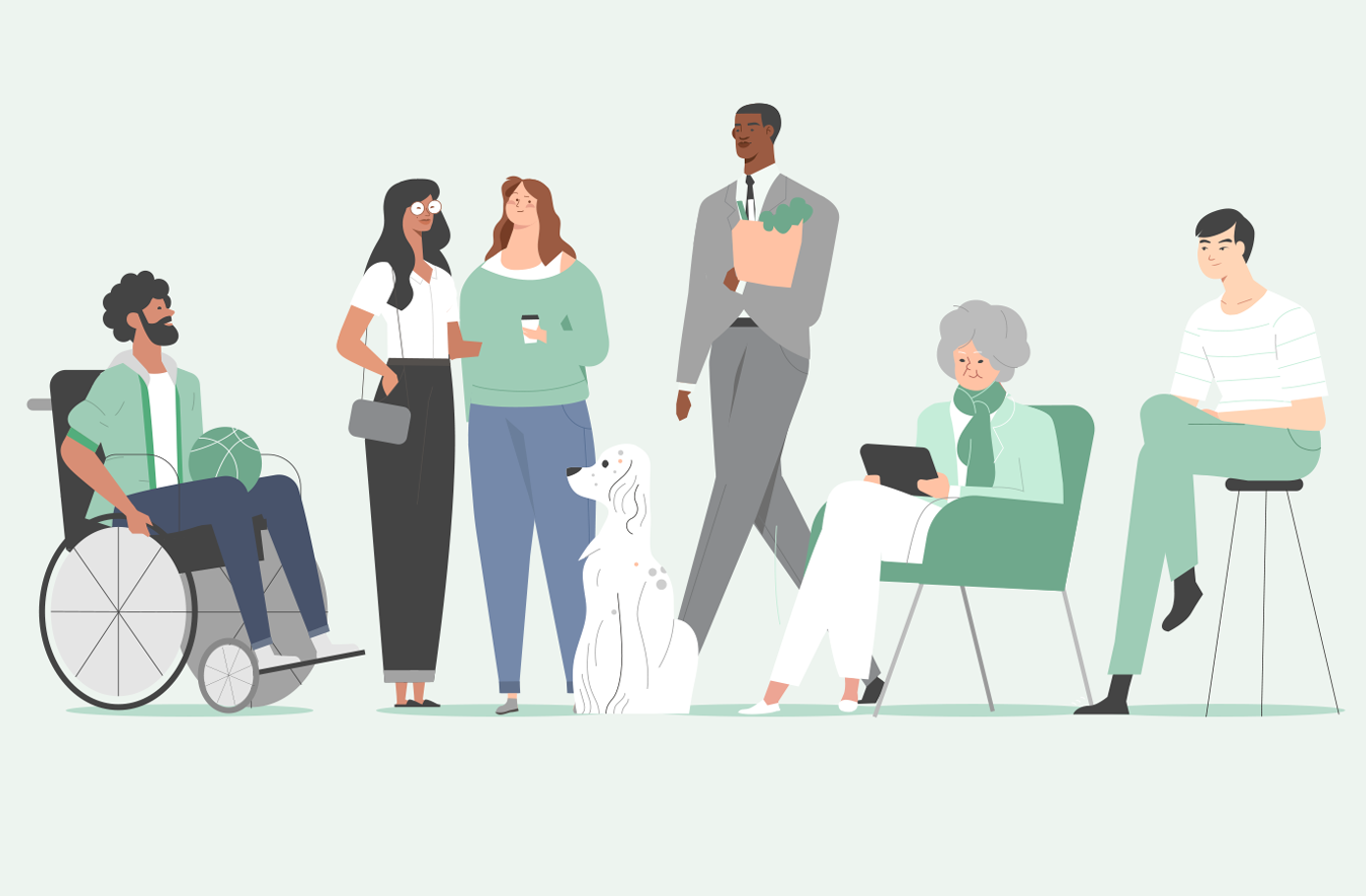
The Truth About Inclusive Motion Design and Why It Matters

Let’s go back in time for a moment.
Way back. To a pivotal moment in the mid-1840s, when a young Belgian mathematician quietly changed how data was used forever.
In one of his most influential breakthroughs, Adolphe Quetelet borrowed a method astronomers used to measure planetary observations and applied it to measuring humans and their behaviour. His first experiment involved averaging out the chest measurements of 5,738 Scottish soldiers. Based on his findings, Quetelet decided there must be a measurable average ideal of everything human — an average intelligence, chest size, body weight, and height, among other things.
According to Quetelet, this average was the gold standard everyone should aim for. Anyone outside that average was abnormal and lesser than. With that, the idea of the 'ideal average' was born. At the time, it was a celebrated breakthrough.
Yet, modern times have shown us this 'ideal average' cannot be used as an accurate measure or representation of humanity.
In fact, this line of thinking is harmful, or even dangerous. The End of Average, a phenomenal book by Todd Rose, describes how the US Airforce designed their first fighter plane cockpit based on the 'average pilot' — and the results were disastrous. Pilots had difficulty reaching the center stick, levers, and foot pedals, so the number of accidents skyrocketed. The solution? They forced manufacturers to invent adjustable seats. Problem solved.
Designing for the ideal average has also given us soap dispensers that only work for light-skinned people, self-driving cars that can’t detect African-American pedestrians and airbags that increase the likelihood of female passengers dying in a car accident.
How is this relevant to advertising, visual communications, and motion design?
After years of looking at one set of brand guidelines after another, we noticed a pattern. Big brands are failing the diversity and inclusion test.
Mass-produced media is designed around the outdated notion of the ideal average. In corporate illustration and motion design, you see perfect people with the same body types, facial features, age, and ability. If you’re lucky, they’ll all be different shades of purple, green and other abstract colours.
This uniformity represents fake diversity and minimises the full spectrum — and beauty — of humanity.
Diversity is more than a drop(per) of colour.
This 'ideal average' design approach was created based on 'mainstream' America, with the idea being that creating something within the 'sweet spot' of average would hit the largest audience with a relevant message. After all, the edges outside of the sweet spot don’t matter, right?
Not a chance. This ideal average is outdated, unfounded, and has recently been disproven entirely. The reality is that including people along the outer edges of a bell curve makes media more accessible and relevant to larger audiences. Flattening the bell curve and intentionally representing people traditionally on the margins is the future of effective communications and, indeed, all media.
If we’re being more authentic in live-action production, we need to extend this to illustrated and motion design content. Modern media consumers are open-minded and ready for inclusive storytelling across all mediums.
Let’s give it to them.
We Did Not Invent Inclusive Design
We are simply champions of it.
Kat Holmes (who I would credit as the number one advocate for inclusive design) and her book — Mismatch — were huge influences. Her thinking is what inspired us to create our own version of inclusive design tailored to the motion design industry.
Inclusive Design (we’ve shortened it to InDe), was initially developed as a response to the rise of digital technologies. And to understand how it influences the landscape of media and society at large, we must first explore the current definitions of inclusive design. Microsoft — and Kat Holmes specifically — define InDe as: “A methodology that enables and draws on the full range of humanity. Most importantly, this means including and learning from people with a range of perspectives.”
Another definition, attributed to Susan Goltsman, a pioneer in the playground and environmental design, is: “Inclusive design doesn’t mean you’re designing one thing for all people. You’re designing a diversity of ways to participate so that everyone has a sense of belonging.”
Inclusive design welcomes all, yet it places importance and weight on giving underrepresented talent a voice in the design process. In turn, this opens up the end result to a wider range of audiences. Inclusive design celebrates a diversity of thought and experience.
It’s important to note that inclusive design isn’t the same as an accessible design or universal design. Accessible design is an attribute, and universal design is rooted in architecture and environmental design. In contrast, inclusive design is a methodology that aims to make digital products more widely useable. It’s not one size fits all, but “one size fits one.”
Inclusive Motion Design — Our Path Forward
We’ve covered two existing definitions of inclusive design: Kat Holmes’ (Microsoft) version is for UX, UI, and product design, while Susan Goltsman’s definition is for environmental and playground design.
Inclusive motion design is different. It critically examines how content is created and how visual communicators and artists portray images on-screen to communicate with viewers. Inclusive motion design is a methodology, a process, and an outcome, and it has two key pillars:
1) Representation (both behind-the-scenes and on-screen)
2) Accessibility
For brands, agencies, and production companies that employ creatives, inclusive motion design means “designing with, not for.” With this in mind, we can broadly define inclusive motion design as the following:
A design methodology that champions diversity and inclusion behind-the-scenes to create content on-screen that’s relatable and accessible to a wider audience.
Methodology
The ultimate goals of inclusive motion design are representation and accessibility. To unlock them, it’s necessary to consider both the process and the outcome.
Behind-the-scenes: It’s critical to assemble a diverse team, keeping in mind that diversity can mean many things: age, background, experience level, ability, expertise, gender, and ethnicity, to name a few. If your internal teams don’t include members of your target audience, hire a freelancer or consultant, if possible.
Ensure your team is comprised of people who understand general biases, as well as their own ability biases. For creatives, an ability bias is defined as how we see the world using our abilities as a baseline.
To create meaningful and lasting change, underrepresented talent should not only participate but also hold leadership roles on creative teams whenever feasible. To put the current lack of leadership into perspective, consider this: While women command 73% of purchase decisions across the globe, only 29% of creative directors are women. It’s clear that women must be more equally represented on design and creative teams, particularly in positions of leadership.
On-Screen: How can your team think beyond the generic notion of diversity? Challenge everyone to push the envelope by empowering those who are traditionally underrepresented on-screen. Here are a few of the many ways to do this:
- Send a strong, positive message with your designs. We are all equal, interdependent, and better and stronger together.
- Create characters that represent the full spectrum of humanity. People in the real world vary in size, shape, height, facial features, age, gender, skin tone, and ability. Go beyond simply applying different skin tones to portray people of different ethnicities.
Empower underrepresented populations. Depict women and underrepresented populations in strong, leadership roles. Ensure they convey confidence through their body language, movements, and key poses.
Adhere to the American Disability Act guidelines for video. Here’s a great resource for making online video accessible.
The Business Case
Big businesses like IBM learned to differentiate through design years ago. They understood that good design is good business, and that it directly affects the bottom line. Now, we can help brands differentiate even further through inclusive motion design — and there’s a compelling business case to embrace it.
1) Customer engagement and contribution
Larger, broader audiences adopt products that are easy to use. What did Apple do to revolutionise computers and phones? They made them easy to use, so more people bought them. The same principle applies to inclusive motion design. In web terms, when you make something easy to understand and use, the end product becomes 'stickier.' In video terms, it becomes more shareable.
Whenever possible, invite members from underrepresented communities to watch your video campaigns or critically examine your designs. Their insights about things that bother them are difficult to use, or hard to understand will make your content better and more appealing to a wider audience.
2) Increasing the size of your addressable market
Inclusive motion design gives brands more reach and affords them relevancy to more people. It opens up new possibilities and makes previously excluded populations more interested in engaging with a brand. Perhaps most importantly, it shows underrepresented groups that they matter — and they will usually spend more money, time, or attention on brands that include them.
Modern consumers are educated, aware, and forever curious. They are conscious of brand values and make purchase decisions, both large and small, based on whether they agree with those values. Diversity and inclusion are highly regarded by a range of demographics, and wise, strategic companies lead with their values. Their total market approach to advertising and design is finally starting to reflect this massive cultural shift, and brands are growing their revenues by embracing, not eschewing, previously marginalised and underrepresented groups.
As a renowned author, computer scientist, academic scholar, and graphic designer John Maeda said in his 2018 Design in Tech Report, Inclusion = INCLU$ION.
3) Greater innovation
Studies such as Delivering on Diversity by international consulting firm McKinsey have unequivocally shown that companies with diverse workforces are the most innovative and perform better financially. This translates directly to small teams working on creative projects.
A key finding from the study notes that diverse and inclusive teams tend to be more creative and innovative than homogenous groups.
“Diverse teams bring different experiences, perspectives, and approaches to bear on solving complex, non-routine problems,” it continues. “Diverse teams are also better able to target and distinctively serve diverse customer markets, such as women, ethnic minority, and LGBTQ+ communities, which command an increasing share of consumer wealth and which could represent untapped markets for some companies.”
Harvard Business Review’s article 'How Diversity Can Drive Innovation' adds that employees of firms with 2-D diversity are 45% more likely to report a growth in market share over the previous year and 70% more likely to report that the firm captured a new market.
4) Avoiding the high cost of retrofitting inclusion and accessibility
There have been several high profile cases in the news recently, creating PR nightmares for brands such as Pepsi and H&M. Netflix was sued in 2012 for violating the American Disability Act (ADA) by not providing closed captioning for its streaming content.
In another landmark class-action lawsuit, Target settled with the National Federation of the Blind for $6 million for accessibility violations on its website.
While it’s difficult to quantify the negative impact on sales that these gaffes had, excluding potential customers, enduring costly litigation, and retrofitting inclusion can be avoided by ensuring that the teams designing these ads, websites, and closed-caption systems are inclusive from the beginning.
Smart, progressive firms are preventing significant missteps by proactively ensuring diversity of thought in all aspects of their businesses.
5) Standing out with authentic representation
While most of us are keenly aware that stock photos and videos stand for fake perfection, most designers still don’t see design and illustration in the same way. Commercial illustration tends to portray outdated, idyllic conceptual models of men, women, and society at large — the middle line of the bell curve.
Through inclusive design, modern firms can differentiate from the competition by representing a more accurate and authentic version of society.
“Our modern conception of the average person is not a mathematical truth but a human invention, created a century and a half ago by two European scientists to solve the social problems of their era.” ― Todd Rose, The End of Average: How We Succeed in a World That Values Sameness
Here are some great examples of inclusive design thinking in the creative business world:
You Can’t Just Draw Purple People And Call It Diversity + Shopify Illustrations
Why I Used A Brown Hand For The “Add To Slack” Button
CutoutMix for architectural renderings by Francesca Perani
Challenges Facing Inclusive Design Practitioners
There are many challenges facing those who are committed to InDe. The diverse talent pool in the motion design, production, and ad agency world is embarrassingly small.
According to The 3% Movement, only 3% of creative directors at US advertising agencies were female in 2012. Today, that number sits at 29% — a pretty astonishing, yet sobering increase.
The AIGA Diversity & Inclusion Impact Report. Quite depressing.
The most recent AIGA Diversity and Inclusion Impact Report find that only 10.6% of designers are Latinx, 8.4% are Asian-American, and 5.1% are African-American. Just over half (54.8%) are women.
While there are no statistics about diversity in motion design specifically, the numbers are likely even lower.
Shrinking budgets and more deliverables also make it harder to practice certain aspects of inclusive design. In a project-based world, it has been difficult to convince some clients to fully embrace our process.
Clients need work produced quickly and cheaply, and ensuring our teams reflect the target audience hasn’t been an exact science; we’re sometimes forced to ask friends for favours to quickly check a concept of design, rather than properly hiring them and taking time to vet our creative output.
In the visual arts, and specifically online video or broadcast commercial work, it isn’t always possible to create a truly inclusive product that is useable by all.
While video campaigns that are completely accessible to visually impaired, deaf, or hard of hearing audiences are ideal in theory, achieving this simply isn’t possible on every engagement. That’s okay; we accept that we won’t reach 'full inclusion' on every project. Inclusive design is never-ending and requires continuous adjustment and re-evaluation.
At BIEN, our mission is to add at least one aspect of inclusive design into every project we do.
We extend this challenge to everyone reading this and to do something today.
Leadership:
• Hire diverse people and include them early on
• Train existing teams to use the inclusive design process
• Revise brand guidelines
• Monitor and evaluate content to ensure they meet InDe standards
Designers/Illustrators:
• Overcome your ability and unconscious biases
• Ensure your work is ADA compliant and accessible (where possible)
• Implement ground-up, boots-on-the-ground change, no matter how subtle. (For example, draw a black or brown hand — like Diógenes Brito did for Slack)
Producers/Account Managers:
• Include this process in discussions with in-house team members, vendors, and clients to ensure an optimal outcome. Trust us, your clients will appreciate the extra care.
Vision for the Future
A world built upon the pillars of inclusive design will be more expansive, exciting, complex, and nuanced. New, fresh stories will be told and the way we see the world will change.
Illustrated and animated content will authentically celebrate and embrace the unique physical traits that make us human.
Jobs that require creative thinking will be in high demand―ones that can’t be replaced by artificial intelligence.
In the future, the playing field will even out.
Digital technology and the internet provide everyone a platform to create and distribute content that is tailored to specific audiences. Barriers won’t exist — not online, in the classroom, office, or on the screen. In 20 years, we’ll reach “creative equity,” where creatives huddled in a room together will truly reflect the diverse crowds passing by on sidewalks and engaging with one another on social media.
People are slowly but surely seeing others like themselves working in the creative landscape and on screens, both big and small. That visual representation will inspire many of their children to become designers, animators, filmmakers, and creative directors.
There’s no doubt―the future is inclusive.
---
This article was written by Ricardo Roberts (Executive Producer) and Hung Le (Creative Director) of BIEN. For practical application, read our guide on How to Practice Inclusive Motion Design.
If you are in a leadership or design role at a studio, agency or brand, you can make a difference by sharing this post on social media and implementing the inclusive motion design process with your team. Thank you.













